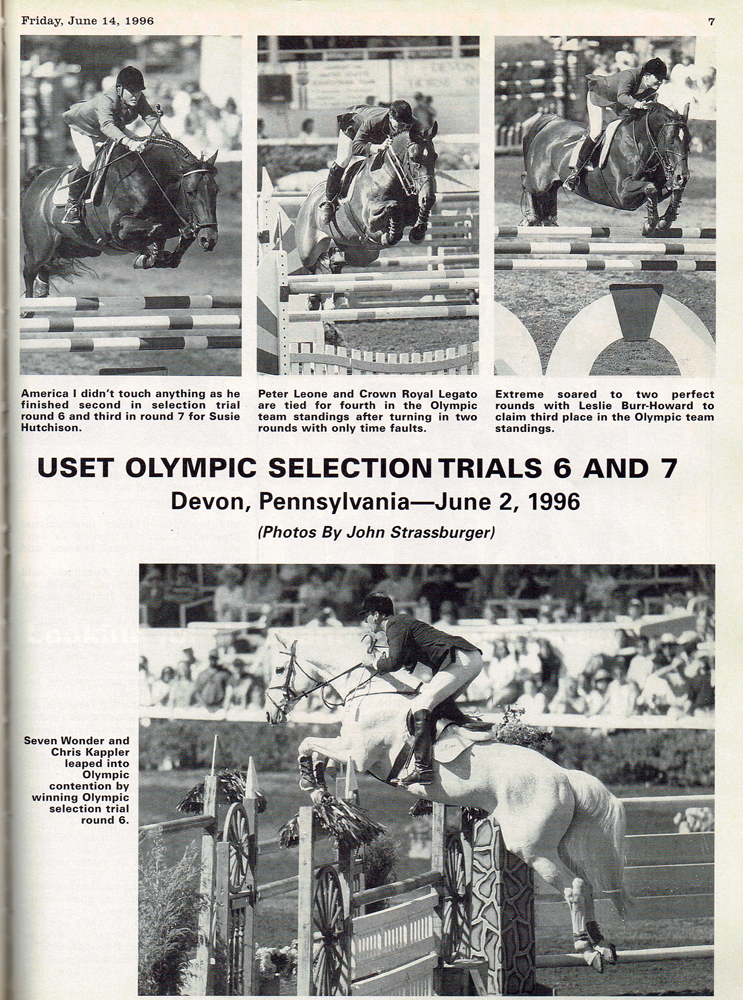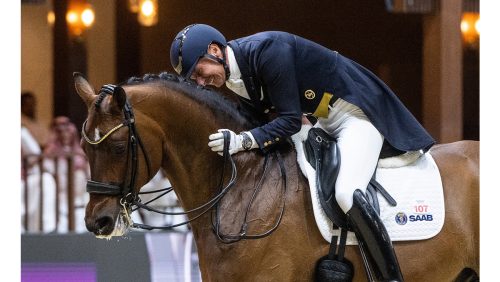As the team for this year’s Rio Olympic Games was named this week, I thought it might be interesting to look back at the selection of the team for the Games 20 years ago.
Back in 1996, before the Atlanta Olympic Games, the U.S. selection was hard and fast objective trials. Riders and horses had to jump in eight rounds of competition over the course of three months in Wellington, Fla., Paoli, Pa., North Salem, N.Y., Devon, Pa., and Gladstone, N.J.
And in the end, those trials selected a team—Anne Kursinki on Eros, Michael Matz on Rhum V, Peter Leone on Crown Royal Legato, and Leslie Burr-Howard on Extreme—that would bring home the silver from Atlanta.

Back then, the selection process shifted to an objective ranking after a number of trials after some lawsuits over selection rocked the show jumping world. In recent years, the process has shifted back to a balance of objective results (this year the U.S. Equestrian Federation computer list) and subjective choices after designated Nations Cup observation events. The last year that actual specific selection trials were held was 2012.
McLain Ward and Beezie Madden are the dynamic duo of U.S. show jumping today, but back then it was Kursinski and Matz. The Chronicle’s coverage of the final trial included this:
These selection trials did more than pick the Olympic team: They also demonstrated the virtuosity of Kursinski and Matz, who’s collectively won 33 events on the American Grandprix Association circuit since 1983 and ridden on four Olympics and 70 Nations Cup teams. They carefully prepared their horses for the trials, skipping most of the lucrative events last fall and winter to save Eros and Rhum for the demands of this spring and summer.
The result was that Kursinski and Eros posted clear rounds in trials 1, 3, 4, 5 and 6 and didn’t have to jump in trials 7 and 8. They finished with 8 faults—the two fences they knocked down in trial 2—because all horses could drop the scores from two trials.
ADVERTISEMENT
Matz and Rhum IV, winners of the USET Championship in 1995, scored clear rounds in trials 2, 3, 4 and 7 to finish with 8 faults. Those faults resulted from 4-fault performances in trials 1 and 5.
Both riders said at Devon that they they’d jump in the final trial if they thought it was an important preparatory exercise for their horses. Neither decided to show in trial 8 though Matz did ride Rhum in the welcome stake on Friday. He had one rail down.
Matz said he had let Rhum down for two weeks after the two rounds at Devon on June 2 and jumped the welcome class “to sort of maintain him.”
“I want him to peak again in 30 days for the Olympics, and you can’t keep horses at their peak for a long time. So I decided to let him down and then bring him back up for the Olympics,” said Matz.
Kursinski said she didn’t see any reason to show in trial 8 “because he’s been so perfect. Why ruin a good thing? He can’t wait to go [in another round],” she said.

Both of these veterans are looking forward to riding in Atlanta because they believe they’ve got their best shot ever for team and individual medals.
And it will be in front of the home crowd.
ADVERTISEMENT
“I love this—there’s no experience like riding in the Olympics,” said Kursinski. “Cannonball [her 1992 Olympic mount] was a little bit green, so I’m glad Eros has peaked at the right time.”
Matz said he best chance for an Olympic medal might have been 1980, when he didn’t get a chance to go to the alternate Olympics on Jet Run. A year later, Jet Run won the 1981 FEI Volvo World Cup Final. “This might be my last chance, so I hope it’s my best shot,” said the 1995 Pan Am Games individual gold medalist with a smile.
At the close of the trials, the riders had expressed optimism about their chances…
It’s an optimism they haven’t expressed in 10 years, an optimism they didn’t have when the trials began in Wellington.
“It’s the best we’ve looked in years,” Burr-Howard said.
“It’s a good team, and it’s getting better,” said Frank Chapot, who’ll be the chef d’equipe for his fifth straight Olympics. He then admitted his concern that perhaps the selection process of eight rounds over 10 weeks had been too demanding. “I just hope we didn’t leave any part of the Olympic Games in any of these rings.”
Some interesting tidbits about the trials 20 years ago…
- He’s now the chef d’equipe of the U.S. show jumping team, but back in 1996, Robert Ridland designed the first five courses of the Olympic selection trials. He then served as the technical delegate for the final three trials, which Linda Allen designed.
- The 1996 trials were the first for now-four-time Olympic team member McLain Ward, who was just 20 then. He showed Orchestre and Omnibus in the trials and after trial 7 was tied for fourth with Orchestre. But 8 faults in the final trial dropped them to seventh in the final team standings. The next round of Olympic trials—in 2000—would see Ward make his first team with Sapphire.















